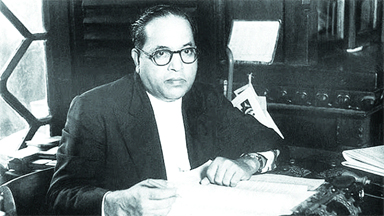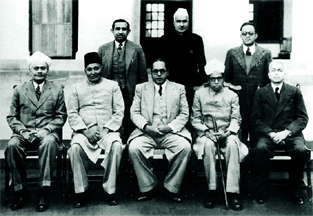
Ambedkar Jayanti, observed annually on April 14th, commemorates the birth anniversary of Dr. Bhimrao Ramji Ambedkar, fondly known as Babasaheb. A social reformer, jurist, economist, educator, and political leader, Dr. Ambedkar is most renowned for his pivotal role as the principal architect of the Indian Constitution. Ambedkar Jayanti is not merely a celebration of a birth; it is a tribute to a visionary who dedicated his life to fighting social injustice and advocating for equality and human rights. As India continues to strive towards a more inclusive society, Dr. Ambedkar’s teachings and legacy remain more relevant than ever.
Early Life and Struggles
Dr. B.R. Ambedkar was born on April 14, 1891, in the town of Mhow in the Central Provinces of British India (now in Madhya Pradesh). He belonged to the Mahar caste, which was considered ‘untouchable’ in the traditional Hindu caste hierarchy. From an early age, Ambedkar experienced the sting of caste-based discrimination. Denied access to equal educational opportunities, public resources, and even drinking water, his early years were marked by severe social exclusion.
Despite these obstacles, Ambedkar’s determination and brilliance shone through. Encouraged by his father, who believed in the transformative power of education, Ambedkar pursued his studies with dedication. His early education was riddled with challenges, including being forced to sit separately in classrooms and facing widespread prejudice from both peers and teachers. These formative experiences would deeply influence his later activism and ideological commitments.
Academic Brilliance and Global Education
Ambedkar’s academic journey was nothing short of extraordinary. After completing his matriculation from Elphinstone High School, he pursued a degree in Economics and Political Science from the University of Bombay. Recognizing his potential, the Maharaja of Baroda sponsored him to study abroad.
Ambedkar earned a master’s degree and a Ph.D. in Economics from Columbia University in the United States. His thesis, “The Evolution of Provincial Finance in British India,” was groundbreaking. Later, he moved to the London School of Economics (LSE), where he further earned a D.Sc. in Economics. During this period, he also studied law at Gray’s Inn and was called to the Bar.
These academic achievements made Ambedkar one of the most educated Indians of his time. More importantly, his exposure to liberal democracies and modern philosophies profoundly shaped his vision for India. His time abroad gave him a comparative perspective on issues of social justice, governance, and human rights.
Social Reform and the Fight
Against Caste Discrimination
Upon returning to India, Ambedkar took up various teaching and administrative roles. However, his primary focus remained social reform. He launched numerous campaigns against caste discrimination and untouchability. In 1924, he founded the Bahishkrit Hitakarini Sabha (Outcastes Welfare Association) to promote education and socio-economic upliftment among the depressed classes.
Ambedkar’s activism took a more assertive turn in the 1920s and 1930s. The Mahad Satyagraha of 1927 was a watershed moment. Ambedkar led thousands of Dalits to drink water from a tank in Mahad, which was prohibited for them. This act of defiance was a direct challenge to the caste order. Later, in 1930, he led the Kalaram Temple entry movement, demanding the right for Dalits to enter Hindu temples.
Perhaps his most controversial act was the public burning of the Manusmriti, an ancient Hindu text that codified caste discrimination. Ambedkar saw this as a symbolic rejection of the religious and cultural basis of social inequality.
Political Journey and the Poona Pact
Ambedkar’s political journey was deeply intertwined with his social activism. In 1932, he engaged in intense negotiations with Mahatma Gandhi during the British-sponsored Round Table Conferences. The British had proposed separate electorates for Dalits, which Gandhi opposed. This led to a historic compromise known as the Poona Pact. Instead of separate electorates, the agreement provided reserved seats for Dalits within the general electorate.
While the Poona Pact was a political compromise, Ambedkar was dissatisfied. He believed separate electorates were essential for genuine political representation of the marginalized. Nevertheless, he continued his political work and founded the Independent Labour Party in 1936 and later the Scheduled Castes Federation.
Architect of the Indian Constitution
The most enduring aspect of Ambedkar’s legacy is his role as the Chairman of the Drafting Committee of the Indian Constitution. After India gained independence in 1947, the Constituent Assembly was tasked with framing a new constitution for the country. Ambedkar was appointed to head the committee due to his legal acumen, intellectual prowess, and deep understanding of Indian society.
Under his leadership, the Constitution of India was drafted with an emphasis on justice, liberty, equality, and fraternity. It abolished untouchability, guaranteed fundamental rights to all citizens, and established the framework for a secular, democratic republic.
Some of the key provisions influenced by Ambedkar include:
– Article 15: Prohibition of discrimination on grounds of religion, race, caste, sex, or place of birth.
– Article 17: Abolition of untouchability.
– Article 46: Promotion of educational and economic interests of Scheduled Castes, Scheduled Tribes, and other weaker sections.
– Provisions for affirmative action and reservations in education and public employment.
Ambedkar believed that political democracy must be accompanied by social and economic democracy. He warned that mere legal equality would not suffice if deep-rooted social hierarchies remained intact.
Conversion to Buddhism
In the later years of his life, Ambedkar grew increasingly disillusioned with the Hindu social order. He believed that the caste system was intrinsically linked to Hindu religious doctrine and that true liberation for Dalits was impossible within its framework.
On October 14, 1956, in a historic event at Nagpur, Ambedkar converted to Buddhism along with over half a million of his followers. This mass conversion marked the beginning of the Dalit Buddhist movement. Ambedkar embraced Buddhism for its emphasis on rationality, compassion, and egalitarianism. He authored “The Buddha and His Dhamma,” which remains a seminal text for modern Buddhist thought in India.
Legacy and Impact
Dr. Ambedkar passed away on December 6, 1956. However, his legacy has only grown stronger with time. He is remembered not only as the principal architect of the Indian Constitution but also as a symbol of resistance against oppression. His thoughts and writings continue to inspire generations of social reformers, academics, and political activists.
Ambedkar Jayanti is marked by processions, lectures, cultural events, and tributes across India. Statues of Ambedkar are garlanded, and his contributions are remembered with reverence. The day is particularly significant in states like Maharashtra, Uttar Pradesh, Madhya Pradesh, and Tamil Nadu, and among the Dalit Buddhist community.
Ambedkar’s Writings and Philosophical Contributions
Ambedkar was a prolific writer and thinker. His works covered a wide range of topics, including economics, law, religion, politics, and social theory. Some of his most important writings include:
– “Annihilation of Caste”: A scathing critique of the Hindu caste system, originally prepared as a speech but published after it was deemed too controversial.
– “The Problem of the Rupee”: His doctoral thesis that offered insights into monetary policy and financial stability in colonial India.
– “Who Were the Shudras?” and “The Untouchables”: Historical analyses that challenged orthodox interpretations of Indian social history.
– “The Buddha and His Dhamma”: A re-telling of Buddhist philosophy with a focus on social ethics and rational thought.
His philosophical outlook combined liberalism, pragmatism, and a deep commitment to social justice. He was influenced by Western thinkers like John Stuart Mill, Karl Marx, and the Buddha, among others.
Ambedkar and Modern India
In contemporary India, Ambedkar’s influence is visible in multiple spheres. From the legal framework to affirmative action policies, his ideas have shaped the country’s democratic ethos. Movements for social justice, anti-caste activism, and Dalit rights often draw upon Ambedkarite thought.
His image is ubiquitous – on posters, murals, academic syllabi, and even currency notes. Universities, public institutions, and even global bodies like the United Nations have acknowledged his contributions. In 2015, the Indian government launched the “Stand Up India” scheme inspired by Ambedkar’s vision of entrepreneurship and economic empowerment for marginalized communities.
Global Recognition
Dr. Ambedkar’s legacy is not confined to India. He is recognized globally as a champion of human rights and social justice. Statues and memorials dedicated to him exist in countries like the United States, United Kingdom, Canada, and Japan. His works are studied in international academic institutions, and his ideas resonate with movements against racial, ethnic, and social discrimination worldwide.
In 2016, the United Nations celebrated Ambedkar’s 125th birth anniversary, underlining his global relevance. His philosophy of peace, tolerance, and justice aligns with the core principles of the UN Charter.
B.R. Ambedkar’s Contributions to Indian Society & Governance
1. Architect of the Indian Constitution
One of Ambedkar’s most significant contributions was his role as the Chairman of the Drafting Committee of the Indian Constitution. As the principal architect of the Constitution, he played a key role in framing laws that emphasized justice, liberty, equality, and fraternity.
Key constitutional provisions influenced by Ambedkar include:
– Abolition of untouchability (Article 17)
– Fundamental Rights ensuring equality and non-discrimination (Articles 14-16)
– Directive Principles of State Policy
– Affirmative action and reservation policies for Scheduled Castes and Scheduled Tribes
His vision laid the foundation for a democratic and inclusive India.
2. Champion of Social Justice
Ambedkar was a relentless crusader against the caste system and untouchability. He launched several movements and organizations to uplift the marginalized sections of society. Notable among them were:
– Mahad Satyagraha (1927) for access to public water resources
– Kalaram Temple Entry Movement (1930) demanding entry for Dalits
– Burning of Manusmriti to protest caste-based discrimination
He founded the Bahishkrit Hitakarini Sabha in 1924 to work for the education and economic improvement of the “Depressed Classes.”
3. Advocate for Women’s Rights
Ambedkar was ahead of his time in advocating gender equality. As the first Law Minister of independent India, he introduced the Hindu Code Bill, which aimed to grant women equal rights in marriage, inheritance, and property. Though the bill faced opposition and was not passed during his tenure, it laid the groundwork for future reforms in women’s rights legislation.
4. Economic Thought and Labor Reforms
Ambedkar was a trained economist and contributed significantly to economic thought in India. His doctoral thesis at Columbia University, “The Evolution of Provincial Finance in British India,” provided deep insights into fiscal decentralization.
As a member of the Viceroy’s Executive Council, he:
– Introduced labor reforms including an 8-hour workday and maternity benefits
– Advocated for state control of industries and social welfare policies
– Proposed the establishment of the Reserve Bank of India, which was later set up in 1935
5. Education and Institution Building
Ambedkar believed education was the key to empowerment. He founded several institutions and emphasized universal education for the marginalized. He established:
– People’s Education Society (1945)
– Siddharth College in Mumbai
– Milind College in Aurangabad
His efforts laid the foundation for educational reforms that aimed to bridge social disparities.
6. Political Leadership and Representation
Ambedkar worked tirelessly to ensure political representation for Dalits and other marginalized communities. He participated in the Round Table Conferences in London and advocated for separate electorates for Dalits. Though the Poona Pact altered this arrangement, it led to the reservation of seats for Dalits in legislatures.
He also founded:
– Independent Labour Party (1936)
– Scheduled Castes Federation (1942)
– Republican Party of India (posthumously based on his ideology)
7. Religious Philosophy
Disillusioned with caste-based discrimination in Hinduism, Ambedkar converted to Buddhism in 1956 along with over half a million followers. He embraced Buddhism as a rational and egalitarian faith and authored “The Buddha and His Dhamma,” a reinterpretation of Buddhist teachings focused on social ethics.
This marked the beginning of the Dalit Buddhist movement, which continues to influence Indian society.
8. Contributions to Law and Jurisprudence
Ambedkar’s legal scholarship contributed to the development of Indian jurisprudence. He emphasized the rule of law, the independence of the judiciary, and the importance of constitutional morality. His legal writings and speeches are widely studied in Indian law schools.
9. Global Recognition and Influence
Ambedkar’s contributions have received global acknowledgment. His thoughts on social justice resonate worldwide. Statues and memorials dedicated to him exist in the UK, USA, and Japan. In 2016, the United Nations commemorated his 125th birth anniversary, recognizing him as a global icon of equality and justice.
Dr. B.R. Ambedkar’s contributions to India are vast and enduring. As the principal architect of the Constitution, a champion of the oppressed, and a visionary leader, he reshaped Indian society. His work in law, economics, education, and social reform continues to inspire millions. Honoring his legacy means striving toward a more just, equal, and democratic India-an India that realizes the dreams of its greatest nation-builder, Babasaheb Ambedkar.





Be the first to comment